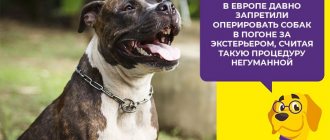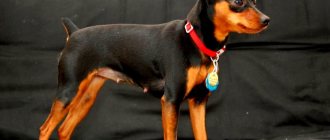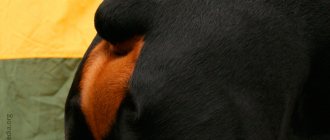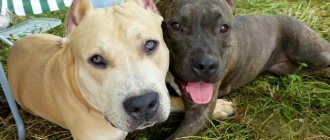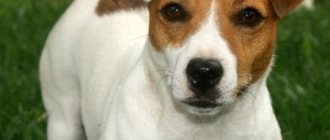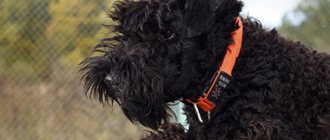Ear cropping for Staff dogs is a cosmetic procedure that until recently was considered mandatory in accordance with breed standards. But now in many countries the operation is not only discouraged, but also prohibited. However, in Russia it is carried out at the request of the dog owner. Cupping has some contraindications and must be done at a certain age. Therefore, before deciding to undergo surgery, you should carefully study its conditions and the features of the pet’s further recovery.
Why do you need cupping?
The older the dog, the longer the recovery period after docking.
The Staffordshire Terrier is a strong and resilient dog. Her head is wide, her muscles are well defined. The eyes are deep-set. The coat is short and shiny. The color may vary, but the “black Boston” look is widespread. He has white on his face, back, neck, paws, and the rest of the parts are black.
Staffords were specially bred to participate in dog fighting. In skirmishes, the possibility of damage to the ear tissue arose quite often. This led to significant blood loss in the pet. Therefore, a Stafford with standard ears was considered unsuitable for participation in such events. Over time, docking became a tribute to fashion and was considered an integral part of the standard of this breed. An undocked Stafford was not allowed to participate in exhibitions.
However, over time, everything changed. In Europe and the USA, this procedure was classified as prohibited. Staff dogs with undocked ears are considered the standard of the breed, while dogs with cropped ears are classified as defective. Owners who initiate this procedure may be held liable for cruelty to animals.
This operation is still being carried out in Russia and the CIS countries. Many owners of dogs of this breed still believe that it is necessary to crop staff’s ears for decorative purposes. This, in their opinion, gives the dog a more aesthetic appearance.
Important! Docking is the partial removal of the ears, and in some breeds, the tails, which is performed by a veterinarian.
Staffordshire Terrier ear cropping
Ear cropping for representatives of the Staffordshire Terrier breed is an open and debatable issue. Some are in favor, citing the traditional appearance of dogs, while others are sharply against it and consider it abuse of the animal. This is a traditional procedure that was considered mandatory for tens, if not hundreds of years, but the new century has made its own adjustments.
At the moment, the standard allows the animal to have a full-fledged ear, so cosmetic surgery to shorten it and give it a certain shape has become a personal choice of the breeder.
Is this procedure necessary?
Staffies are an old and specific breed. The tradition of shortening ears and tails appeared in the ancient world and has passed through the entire history of mankind for two reasons:
- From a purely utilitarian point of view , a fighting and guard dog regularly has to get into fights, and in this case the tail and ears are the most vulnerable parts of the body that can be wounded. And if the bleeding is not very strong, then the likelihood of getting an infection and dying because of this is very high.
- Prejudice is also surprisingly tenacious. In the Middle Ages, people believed that having a long tail or ears could cause a dog to become infected with rabies. Naturally, this is not so. A docked dog has exactly the same chance of getting sick as a tailed-eared dog.
- Familiar appearance and breed standard . Once upon a time in America and Europe, this beautiful, powerful animal was recognized as worthy of exhibiting at an exhibition only if parts of its body were shortened. Even one of the points by which the animals were evaluated was the accuracy and correctness of the cuts. But those times are long gone. Now the whole world has abandoned such prejudice. The dogs perform in their natural form and also compete for champion titles.
- Recognizable look . Still, small neat triangles on the head are a distinctive feature of the staff; most ordinary people recognize the dog precisely by them. Specific natural ears, similar to rose petals, framing the muzzle on the sides, make the animal unrecognizable. This is why most Russian breeders subject their pets to this procedure.
Features of the operation
The procedure is performed in puppyhood. The most suitable period is considered to be from 2.5 to 4 months. At this time, the body is already strong enough to withstand anesthesia, but serious bleeding can be avoided.
12 hours before the start, the dog stops feeding, but is given as much water as needed.
After falling asleep and fixing on the operating table in immobility, the procedure begins.
To ensure that the cuts are symmetrical, special clamps are used - patterns; they allow you to determine exactly how much needs to be cut.
The shape of the cut may be different. Usually the owner is offered several options. From the simplest to the most fashionable. Naturally, the price of cupping changes in this case.
After cutting off the excess, the edge is finished with seams. In modern clinics, they use dissolving threads so that they do not need to be removed in the future. It is extremely important to sew the edge carefully, catching only soft fabrics. Damaged cartilage is considered an indicator of rough work.
What happens after?
The rehabilitation period will last about a week, until the stitches are removed and a final examination by the surgeon is carried out, who must confirm that everything has healed well.
All this time, the puppy will need his owner much more than usual, because he will have to recover. Successful recovery is accompanied by certain measures and precautions:
- When the puppy comes out of anesthesia, you should be nearby, as he may vomit. In the first 12 hours, feed only small portions, monitor the reaction to the foods.
- Every day, using sterile instruments, carefully wash the cut area with a special product, and then treat it with brilliant green.
- If you suspect inflammation, contact your veterinarian immediately, as there is a high risk of infection.
- Walk only in dry weather, but try not to spend a lot of time in direct sunlight so that the animal does not overheat.
- After each exit outside, we treat the incision with an antiseptic. And we wash off the crusts that appear with a special product.
- After saying goodbye to the seams, the installation of the ears awaits. For some time they are glued in the form of horns so that the cartilage straightens and adjusts to the correct location.
- The diet does not change during recovery, provided that before that it was balanced in accordance with the needs of the age.
Complications
If the operation was performed without hygienic requirements, by a not very professional doctor or without proper examination, then serious side effects are possible:
- Bleeding due to unsuccessful or incorrect incision.
- Inflammation at the suture site. Although this is most often the result of improper wound care after the procedure.
- Scarring leading to significant thickening of the edge.
- Infectious blood poisoning, which in difficult situations can lead to the death of a dog.
- Consequences of general anesthesia. This may include prolonged nausea and disorientation, or there may be more serious consequences associated with damage to the cerebral cortex. If the dog develops a severe allergy to the injected drug, it can also be fatal.
Despite the fact that cosmetic intervention is minimal and does not affect any vital organ, it is still worth remembering that its consequences can be fatal. If you decide to circumcise your pet, undergo a full examination before doing so and entrust all manipulations to an experienced surgeon in a well-equipped clinic.
Source: https://clubsobak.ru/2019/10/23/kupirovanie-ushej-staffordshirskogo-terera/
Contraindications
Like any other operation, this procedure has certain contraindications. If they are present, ear cropping cannot be carried out:
- general weakness;
- elevated temperature;
- lack of appetite;
- vomit;
- loose stools;
- apathy.
If any of these symptoms are present, you should take your pet to a doctor. Only a specialist can correctly diagnose and prescribe a course of treatment.
Docking is prohibited if the puppy has developmental abnormalities
Is it worth cropping a staff's ears: pros and cons
This procedure has supporters and opponents. Therefore, debates on this matter continue constantly. However, there are situations when ear cropping for a Staffordshire Terrier is recommended for medical reasons.
Among them:
- frostbite, burns;
- purulent-infectious inflammations that are not amenable to other types of treatment;
- complex injuries;
- neoplasms;
- obstruction of the ear canals.
Owners of staffs who decide to undergo the procedure for decorative purposes should take into account that the operation can negatively affect the health of the pet.
Possible consequences:
- inflammation;
- scarring;
- tissue compaction in the incision area;
- repeated bleeding;
- necrosis of ear areas;
- infectious brain damage.
Considering the seriousness of this procedure, it is recommended to do it consciously and only as prescribed by a specialist.
Important! The need for cupping for medical reasons is determined by a veterinarian.
Amstaff ear cropping: age, procedure, forms
Ear cropping for Staff dogs was previously considered mandatory and was required by the breed standard. Today it is a cosmetic procedure, the necessity of which is hotly debated. Some owners claim that it will protect the dog from injury and infection, while others consider the operation to be a cruel and useless intervention.
What resection brings more benefit or harm, how it is carried out and how much it costs is described in the article.
General information about the procedure
Many dog breeders consider the procedure for cropping dogs' ears to be a personal whim of the owners. However, according to veterinarians, partial amputation of the ears often prevents the development of various pathologies. The operation is recommended for those dog breeds that are genetically predisposed to ear diseases.
Ear cropping is recommended for representatives of fighting and hunting breeds
What is the procedure for ear cropping in dogs? Under general anesthesia, the veterinarian removes the top of the ear. Most often, half of the ear is subject to amputation, much less often – the third part. The first few days after surgery, the pet needs special care and attention from the owner.
Ear cropping does not have a reverse “move”. Before deciding to undergo surgery, carefully weigh the pros and cons. Most European countries have long abandoned this procedure; Russian dog breeders have still not reached a consensus.
At what age should the procedure be performed?
For cosmetic purposes, staff's ears are cropped at an early age. This is due to the fact that at this stage of development, wounds heal faster, and the likelihood of complications is much lower.
Veterinarians, in response to the question of how many months is best to crop staffs’ ears, recommend not delaying this procedure. The optimal age is 1.5-3 months. But in exceptional cases, it is possible to perform the operation a month later, but no more.
According to medical reasons, this operation is carried out regardless of the dog’s age, since its goal is to restore the pet’s health.
If the timing is delayed, cupping may not give the desired result.
Cost of the procedure
How much cupping costs depends on:
- veterinary clinic pricing policy;
- the age of the puppy - the older it is, the more expensive the resection costs;
- the quality of the materials used - mainly anesthesia and sutures;
- location of the procedure - for calling a doctor to your home you will have to pay an additional 500 - 1,000 rubles.
The average price for ear cropping of a Staffordshire Terrier in Moscow is 4,000 rubles. The minimum you will have to pay is 1,000 rubles, the maximum is 6,000 rubles. Correcting previously incorrectly cropped ears costs more - 10,000 rubles.
Ear cropping for a Staffordshire Terrier today is a purely cosmetic procedure. Moreover, in America and European countries, the operation is a reason for disqualifying the dog and fining the owner. But in Russia, resection is allowed, and each owner decides individually whether to do it or not.
This veterinary operation has an ancient history. The first such manipulations were carried out during the existence of the Roman Empire. Dogs serving with legionnaires had their ears shortened to supposedly protect them from rabies. This is where the tradition came from that ear cropping of breeds (Staffs, Alabais, Dobermans and others) is a mandatory procedure. True, short ears gave them an advantage in battle - the four-legged fighter became less vulnerable to the enemy’s teeth. For hunting dogs, the reason for the operation is similar; they also sometimes enter into a fight with the animal, especially since small ears are more difficult to damage, and foreign objects are less likely to get into them. And in most cases, surgical formation has to be carried out due to the requirements of breed standards. Recently, cupping as a mandatory procedure has lost its relevance. Many European countries have even banned dogs with artificial ears from participating in dog shows. However, a fairly large percentage of animal owners still consider trimming this part of the body appropriate both from an aesthetic and necessity point of view.
How to prepare a dog
The operation requires preliminary preparation of the dog. Docking is only done on healthy dogs. If the dog was infected, then at least 10 days must pass after his recovery.
In this case, the staff must be vaccinated on time. The best option is to end the vaccine quarantine. At the preparation stage, treatment against parasites should be carried out. This procedure must be done 10 days before the intended operation.
Cupping is performed under anesthesia. Therefore, the dog cannot be fed for 12 hours before this, and water can be given in unlimited quantities.
Description of the procedure
Ear cropping by staff is performed under general anesthesia. The duration of the operation is 1.5-2 hours. The veterinarian begins the procedure after the effect of anesthesia.
Procedure:
- The hair on the ears is shaved.
- The incision sites are treated with an antiseptic.
- A special pattern is applied to the auricle.
- Deletion in progress.
- Wounds are treated with an antiseptic.
- Stitches and bandages are applied to prevent excessive bleeding.
There are several ear cropping techniques. The difference between them is the shape and size of the ears. Therefore, you should make your choice in advance.
Important! The height of the cropped ear of a Staffie should correspond to the distance from the inner corner of the eye to the front edge of the ear.
The dog's eyes remain half-open during anesthesia.
What do you need to know about the Staffordshire Terrier ear cropping procedure?
Many dog breeders consider the procedure for cropping dogs' ears to be a personal whim of the owners. However, according to veterinarians, partial amputation of the ears often prevents the development of various pathologies. The operation is recommended for those dog breeds that are genetically predisposed to ear diseases.
Ear cropping is recommended for representatives of fighting and hunting breeds
What is the procedure for ear cropping in dogs? Under general anesthesia, the veterinarian removes the top of the ear. Most often, half of the ear is subject to amputation, much less often – the third part. The first few days after surgery, the pet needs special care and attention from the owner.
In most cases, the procedure is virtually painless for the animal. It should be noted that the dog’s condition depends on the experience and professionalism of the doctor. You should not trust the life and health of your four-legged friend to an unfamiliar or inexperienced veterinarian.
Ear cropping does not have a reverse “move”. Before deciding to undergo surgery, carefully weigh the pros and cons. Most European countries have long abandoned this procedure; Russian dog breeders have still not reached a consensus.
“How to treat a dog’s ears after cropping”
This video presents recommendations from specialists for caring for animals during the postoperative period.
Indications
The first reason for carrying out cosmetic surgery to remove part of a dog’s ear is remnants of the past. Cupping was used during the reign of the ancient Egyptian pharaohs. As you know, habits formed over centuries take years or even decades to eradicate.
The second reason is the health of the pet or the prevention of the development of ear pathologies. Amputation is recommended for injuries, ulcers, neoplasms of various origins and necrosis of the auricle. A highly qualified veterinarian should make a diagnosis and suggest cupping as a method of solving the problem.
The third reason is the characteristics of the breed. Ear cropping is recommended for representatives of fighting and hunting breeds, including the Staffordshire Terrier. In the process of fighting with other animals, there is a high risk of injury or rupture of the ear.
Cupping prevents the development of ear diseases in Staffies
Types of operations
In modern veterinary medicine, several types of ear cropping are used. For example, the “flame” or “dagger” shape is suitable for Dobermans and Great Danes, the “bear” shape is suitable for Caucasians and Central Asians, and the “mittel”, “devil” or “hatchet” shape is suitable for miniature schnauzers.
Similar article: Description of the Swiss Aristocratic Bernese Shepherd Dog
As for the staff, during the operation it is possible to form a “show”, “fighting”, “long” or “short” version of the auricle.
Ear cropping surgery
Caring for undocked ears involves periodic cleaning and inspection. Cropped ears, especially in the postoperative period, require a lot of time and attention from the dog breeder. Let's get acquainted with the features of the operation and the condition/behavior of the puppy.
Caring for Cropped Ears
Postoperative sutures are treated with hydrogen peroxide, chlorhexidine or any antiseptic. To prevent the dog from itching, it is recommended to wear a special collar for the first days. When the itching goes away, the collar can be removed.
The sutures are removed in a veterinary hospital 7–10 days after docking.
The sutures are removed by a veterinarian 7–10 days after cupping.
Rehabilitation period
When the dog wakes up, the owner should be nearby to make the pet calmer and easier. In some cases, dogs can remain asleep for a long time, but if there is measured breathing, it is not recommended to wake them up. In this case, you need to move the staff to a warm, cozy place and cover it with a blanket. You can additionally use heating pads, since after recovery from anesthesia the dog will freeze.
Within 12-24 hours after surgery, the staff may experience general lethargy and refuse to eat. During the rehabilitation period, it is important to help your pet recover. Therefore, the owner must talk to him, periodically stroke him, and sometimes turn him over to the other side. At first, the dog will have an unsteady gait and poor coordination of movements, which is considered normal and should not cause concern.
If your pet refuses food and nutrition, it is necessary to stimulate its appetite. To do this, drop water into the mouth or smear honey on the staff’s lips. If the reaction is positive, offer the dog his favorite treat.
Important! In case of wound bleeding after surgery, it is necessary to periodically apply a cotton pad moistened with hydrogen peroxide to the cut site.
Postoperative care
There are a number of recommendations that must be followed to ensure that your pet’s ears heal quickly. This allows you to reduce the likelihood of complications to a minimum. 3-4 days after the operation, it is necessary to begin a light massage of the ears. In this case, movements should be directed from the base to the edge of the organ. This procedure allows you to normalize metabolic processes in the ear tissue and promotes rapid recovery.
Stitches after cupping are removed after 10 days
Ear collar
This device helps prevent scratching while wounds are healing. You can find an ear collar at any pet store. The ear collar is made from multilayer durable polyethylene, plastic or cardboard. Its shape can be round or curved.
Daily cleaning of seams with a tampon
Throughout the recovery period, it is necessary to treat the stitches daily with an antiseptic. This procedure avoids infection of wounds. You can use hydrogen peroxide or chlorhexidine for this. During the healing process, any crusts that appear should be soaked and carefully removed. During this period, dust and dirt should not be allowed to get into the wounds.
Important! To quickly restore the staff, it is necessary to give the dog a complex of vitamins.
Walking a puppy in dry weather
Despite the rehabilitation period, the pet must regularly be in the fresh air. Walking should be done in dry weather, as high humidity does not promote wound healing. Upon arrival from the street, it is necessary to treat your pet’s ears with an antiseptic to prevent infection. The number of walks should depend on the pet’s well-being and weather conditions.
What you need to know about ear cropping from staff
Ear cropping of a Staffie is a common procedure performed by a veterinarian at a dog’s early age. The younger the dog, the better it will survive the operation. A high-quality operation and proper care of the owner for the pet will help the animal recover quickly.
Why do you need cupping?
Ear cropping is a surgical procedure in which part of the ear is removed. It is carried out for therapeutic and cosmetic reasons. Manipulation is needed for several purposes:
- Disease prevention. Removal is appropriate in case of organ trauma or necrosis. Undocked Staffies may suffer from ulcerations and neoplasms. The procedure will prevent or relieve the dog from such pathologies.
- Warnings for ear rupture during combat. It is recommended that they be docked for all hunting and fighting dogs.
Some take this step for personal reasons, believing that resection will make the dog look better. For show Staffords, cropped ears are standard.
Contraindications
It is not recommended to resort to this procedure if the dog has mental disorders or developmental delays. Also, surgery should not be performed if the Staffordshire Terrier is not feeling well, manifested by the following symptoms:
- increased body temperature;
- loss of appetite;
- vomiting;
- diarrhea.
At what age should the procedure be performed?
The optimal age category for ear cropping is 1.5-4 months. If removal is performed before the specified time, the animal may not survive the surgery. Later, resection may be ineffective: often the auricles are not formed correctly. Only in case of medical necessity, age is not taken into account, because we are talking about saving the life of a pet.
How to prepare a dog
Before you take your puppy to surgery, prepare him. Initially, make sure that the Staffordshire Terrier:
- Not infected and 7-10 days have passed since possible illness.
- Has not been vaccinated in the last two weeks.
- I was treated for parasites half a month before surgery.
Since the dog is given anesthesia before the procedure, the dog should not be given anything to eat 12 hours before the procedure. Otherwise the staff will vomit.
Description of the procedure
Ear cropping of a Staffordshire Terrier is performed exclusively under general anesthesia. The duration of the manipulation is one and a half to two hours.
Before cropping the ears of Staffy puppies, you need to pay attention not only to the age of the dog, but also to the gender. Breed also plays an important role.
The ear should be the same length as the space between the leading edge of the ear and the inside corner of the eye.
The procedure goes like this:
- The dog is restrained. Place on the stomach, the forelimbs are brought forward, the hind limbs are brought back. The head is also immobilized.
- They give anesthesia.
- Wait for the anesthesia to take effect.
- Hair is shaved from the area of the ears and head.
- The operated area is treated with an antiseptic.
- Removal is carried out. To obtain a symmetrical shape, use a special pattern.
- After circumcision, the wound is treated with an antiseptic and stitches are applied.
- Bandages are applied to stop bleeding.
There are several types of surgical interventions and techniques that veterinarians use. Before deciding to have a resection, you should choose a clinic, a doctor and decide on the desired size and shape of the ears. Those who do not want to go to a veterinary clinic can call a veterinarian at home. This is possible, but the risk of infection in this case increases.
Keep in mind! During the effect of anesthesia, dogs do not close their eyes.
Rehabilitation period
It is advisable for the owner to be present at the moment when the dog recovers from anesthesia. This will make it easier for the staff. It happens that dogs do not come to their senses for a long time. If there is measured breathing, it is not advisable to wake the dog. You just need to put the animal in a warm place or cover it with a blanket (it is allowed to use heating pads), because the staff will freeze while recovering from anesthesia.
Some dogs do not experience any difficulties or malaise after anesthesia; they quickly come to their senses and go to enjoy the well-deserved food. For others, this is more difficult: they may be lethargic for 12–24 hours and refuse food. The owner’s task is to help the pet survive a difficult period. It would be useful to turn the dog from side to side, stroke it, and talk.
Don't be alarmed if the animal is unsteady or hesitant at first - this is normal. It is imperative to make the Staffordshire Terrier drink and eat. There are several tricks that will stimulate your dog's appetite:
- Drop water onto the mouth area and into the mouth.
- Apply honey to the dog's lips and below the nose.
- Offer your favorite food.
Attention! If bleeding occurs, it is recommended to apply a gauze bandage soaked in a solution of hydrogen peroxide to the area.
Postoperative care
In order for the Staffordshire Terrier to recover quickly and the operation to give the desired result, it is worth following a number of recommendations.
Ear collar
Since the wound itches as it heals, it is important to prevent scratching. For such purposes, a special collar is used that is put on the dog. It is advised to wear it until the wound heals.
After this, the itching goes away and the device can be removed. The collar is made of durable multilayer polyethylene, cardboard or plastic. They are easy to find in a veterinary pharmacy or pet store.
The shape of the product can be round or curved.
Daily cleaning of seams with a tampon
To prevent the wound from festering, daily treatment with an antiseptic is required to prevent infection. This could be chlorhexidine or hydrogen peroxide. The crusts that appear are soaked and removed. Also, be careful not to get dust on your ears.
Walking a puppy in dry weather
Don't forget about walking your pet. The dog needs fresh air for a speedy recovery. After going outside, be sure to treat your staff's ears with an antiseptic solution. To calm and obedience the dog at these moments, praise him and give him treats.
Remember! Walking is allowed only in dry weather. Humidity will cause the wound to take a long time to heal.
If the threads are self-absorbing, then the stitches will not need to be removed, but if not, then you need to visit the veterinary clinic 10 days after the operation. For a speedy recovery, it is advisable to give your dog a complex of vitamins.
Possible complications
In rare cases, complications may occur after surgery. The following factors influence:
- the doctor does not have sufficient qualifications and does not adhere to sanitary and hygienic standards during the manipulation process;
- the dog owner does not follow all the veterinarian’s recommendations in the postoperative period;
- the dog has poor immunity;
- improper preparation was made or the pet was sick;
- During the operation and during the recovery stage, drugs were used to which the dog was allergic.
Due to unqualified actions of the doctor or poor care of the owner, the following may occur:
- inflammatory processes, suppuration of sutures;
- hyperemia;
- bleeding;
- rashes;
- scarring and thickening of the edges of the ear.
Attention! In especially severe cases, complications arise all at once.
Inflammation, suppuration
Often, inflammatory processes with the appearance of purulent sacs in the area of the sutures appear if during surgery the doctor used a non-sterile instrument and did not properly treat the resection area. Also caused by suture dehiscence, low immune defense and infectious diseases. Regular antiseptic treatments and the use of antibiotics can stop inflammation.
Hyperemia (redness) and rash
Such phenomena indicate an allergic reaction, which can only be removed with antihistamines.
Bleeding
Significant bleeding occurs in dogs that have surgery at a later age. This is also possible when the animal overheats.
Scarring and thickening of the edges of the ear
Scarring of the Staffordshire Terrier's ears depends on the individual characteristics of the dog. Age plays an important role.
Remember! If the ears of a Staffordshire Terrier are cropped by qualified doctors and in accordance with all sanitary and hygienic standards, then there will be no complications.
How to glue the ears of a Staffordshire Terrier
It is important to set up the staff's ears after cropping. This is a separate procedure that the owner carries out personally. For manipulation you will need:
- 5 cm adhesive plaster;
- cotton swabs;
- cotton buds;
- scissors;
- petrol.
You need to act step by step:
- Cut 4 strips of plaster 30 cm long (2 for each ear). Plus 1 piece 40 cm and another 10 cm, cut it lengthwise.
- Clean your ears with cotton swabs.
- Moisten the adhesive side of the patch with gasoline, this will make it stick better.
- Glue a thin piece to the fold.
- Insert the swab into the ear, leaving the bottom edge 2 cm below the glued patch.
- Raise your ear and apply a thick piece of plaster in a spiral pattern, starting from the outer side of the auricle. While wrapping your ear, pull it up. The ends should remain open a couple of centimeters; they will show whether there is any swelling. You should also not wrap your ear at the bottom, otherwise irritation will occur.
- After gluing both ears, install a jumper between them. Take a 40cm tape and wrap the two ears together.
Important! Never tighten your ears too much. This will lead to swelling.
To check the ears, pull out the swab; there is no need to remove the patch. With such “horns” the dog should leave for 2 weeks.
Ear cropping for Stafford puppies should take place on time and in a specialized clinic. You should not resort to the help of dubious medical workers who do not have the appropriate qualifications.
Source: https://sobaka.guru/uhod/kupirovaniei-ushej-u-staffa/
Possible complications
A staff with cropped ears does not always recover quickly after cropping. This may be due to insufficient qualifications of the doctor, weak immunity of the pet, non-compliance with sanitary and hygienic procedures, or an allergy to the drugs that were used during the operation. As a result, the dog may experience certain health problems.
Inflammation, suppuration
Such complications can occur due to infection of wounds after circumcision. This can happen if unsterile instruments were used during the operation, as well as due to insufficient treatment of open wounds.
Important! To restore your pet's well-being, you need to use antibiotics and antiseptics.
Hyperemia (redness) and rash
The appearance of such complications is a sign of the development of allergies. In this case, you should give your pet antihistamines internally, and treat them externally with antiseptics, which will help reduce discomfort. Which allergy medications to use and in what dosage should be checked with your veterinarian.
Infection in a pet's wound can cause intracranial disease
Bleeding
This complication may occur if docking was performed on an adult dog. It is also possible if the dog overheats. To eliminate bleeding, apply ice wrapped in a cloth to the wounds, and regularly wipe your pet's ears with hydrogen peroxide.
Scarring and thickening of the edges of the ear
Such negative consequences after surgery occur in rare cases. The appearance of scars and thickening of the edges may be due to the individual characteristics of the dog. A similar problem can also occur when performing surgery on an adult pet.
Important! To avoid complications after surgery, it is necessary to carry it out in a veterinary clinic in compliance with all sanitary and hygienic standards.
Advantages and disadvantages
The attitude of the canine community towards the procedure of ear cropping in dogs is ambiguous. In recent years, the claim that this action constitutes an example of cruelty to animals and is not due to vital indications has been gaining popularity in the EU and the USA. Dogs with cropped ears and tails are generally not allowed to enter international dog shows. On the other hand, there is a widespread belief among dog breeders that ear cropping helps prevent otitis media.
, and this operation is recommended for Staffordshire Terriers due to their aggressive nature, because in a potential fight with another dog the risk of ear injury is reduced.
Thematic materials:
Folder moving lexical topic “Winter Making cards for Mother's Day Congratulations, invitations, scripts, toasts, frames, postcards, competitions for you at the Holiday Center! For the Day of Knowledge, have time to prepare greeting cards to all the teachers you know. Parting words to first-graders. It’s easy to make a poster for a friend’s birthday. A wall newspaper for a friend’s birthday.
103583
If you notice an error, select a piece of text and press Ctrl+Enter
